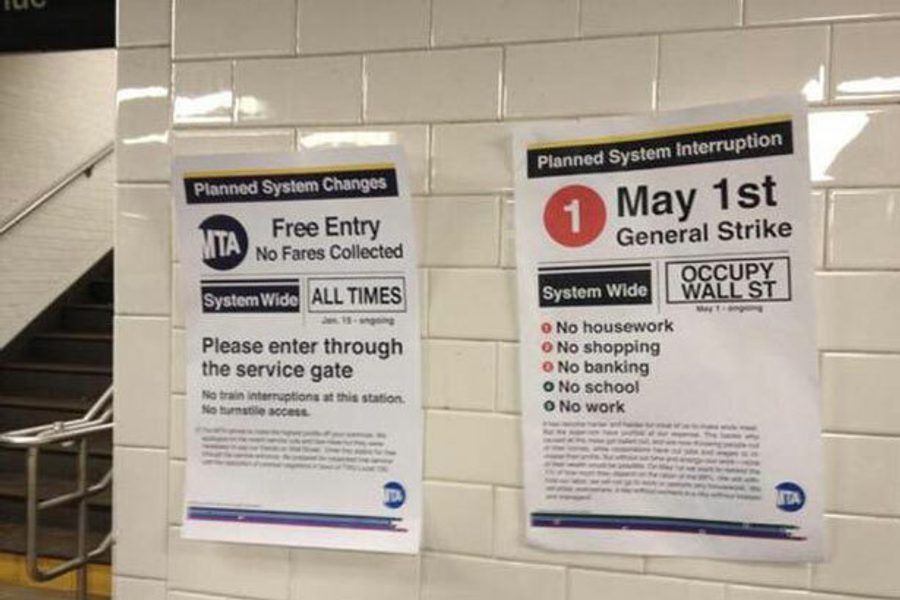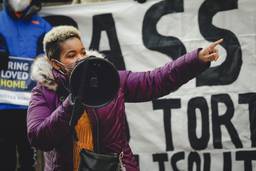
As the NYPD and the FBI continue to hunt for the masked Occupy demonstrators who last week staged a “fare strike” in New York City by chaining open subway entrances, activists in at least 18 cities yesterday held actions to protest rising public transportation fares.
Though strike and shutdown actions by Occupy have at times strained relationships with unions, the Amalgamated Transit Union (ATU) announced earlier this month that it would endorse the National Day of Action for Public Transportation. The New York City fare strike allegedly took place with the cooperation from some rank-and-file members of the Transit Workers’ Union — whose members have been working since January 15 without a contract — though this was denied by a TWU spokesperson.
“We need to be clear that the mass transit crisis was caused in no small part by the diversion of billions of tax dollars to war and the corporations that benefit from war,” said ATU International President Larry Hanley in a press statement. And this has lead [sic] to service cuts, transit worker layoffs, and higher passenger fares which are really just another kind of tax, levied on those who can least afford it.”
Demonstrators also sought to highlight how the central message of Occupy Wall Street could be applied to public transportation: because of risky gambles made by investment banks, transit agencies are deep in debt and poised to write it off on the backs of the poor and working class people who rely on public transportation.
In the past decade, a number of transit authorities entered into interest rate swaps—essentially, bets that rates would stay at or near their present levels — with investment banks. When interest rates dropped dramatically following the financial crisis, transit authorities remained locked into high-interest payments and began losing millions of dollars in payments on their debt. According to the advocacy group MassUnited, the Massachusetts Bay Transit Authority (MBTA) is losing $9 million a year to UBS, $8.9 million a year to JPMorgan Chase and $8.3 million a year to Deutsche Bank. All of these banks received taxpayer bailouts of more than $60 million.
Actions taken during the National Day of Action for Public Transportation included rallies, vigils and leafleting, often undertaken as a joint effort between riders’ and transit workers’ unions.
In Boston, where the local Occupy movement initiated the call for a national day of action on public transit, demonstrators held a rally in front of the State House to protest proposed fare increases and termination of weekend service on two commuter rail lines. The MBTA Board of Directors passed the changes over the objections of about 100 demonstrators.
In Chicago, members of the ATU, National Nurses United, the Chicago Teachers Union, Citizens Taking Action and Occupy Chicago gathered outside the Chicago Transit Authority (CTA) to protest Mayor Rahm Emanuel’s proposal to balance the CTA’s budget by reducing CTA employee benefits and compensation.
In Seattle, the Transit Rider’s Union, which describes itself as “a democratic organization of working and poor people who are dedicated to preserve, expand, and improve the public transportation in Seattle and beyond” teamed up with the ATU Local 587 for informational picketing and flyering to demand adequate funding for public transit.
In Detroit, a candlelight vigil at the the Rosa Parks Transit Center also marked the anniversary of the assassination of Martin Luther King, Jr. — who died on April 4, 1968 — and linked the issue to his legacy. “Public transportation is a human right,” Occupy Detroit organizer Stephen Boyle told the Huffington Post. “Martin Luther King … fought for rights for all people.”

I hope you found this article important. Before you leave, I want to ask you to consider supporting our work with a donation. In These Times needs readers like you to help sustain our mission. We don’t depend on—or want—corporate advertising or deep-pocketed billionaires to fund our journalism. We’re supported by you, the reader, so we can focus on covering the issues that matter most to the progressive movement without fear or compromise.
Our work isn’t hidden behind a paywall because of people like you who support our journalism. We want to keep it that way. If you value the work we do and the movements we cover, please consider donating to In These Times.
Rebecca Burns is an In These Times contributing editor and award-winning investigative reporter. Her work has appeared in Bloomberg, the Chicago Reader, ProPublica, The Intercept, and USA Today. Follow her on Twitter @rejburns.




